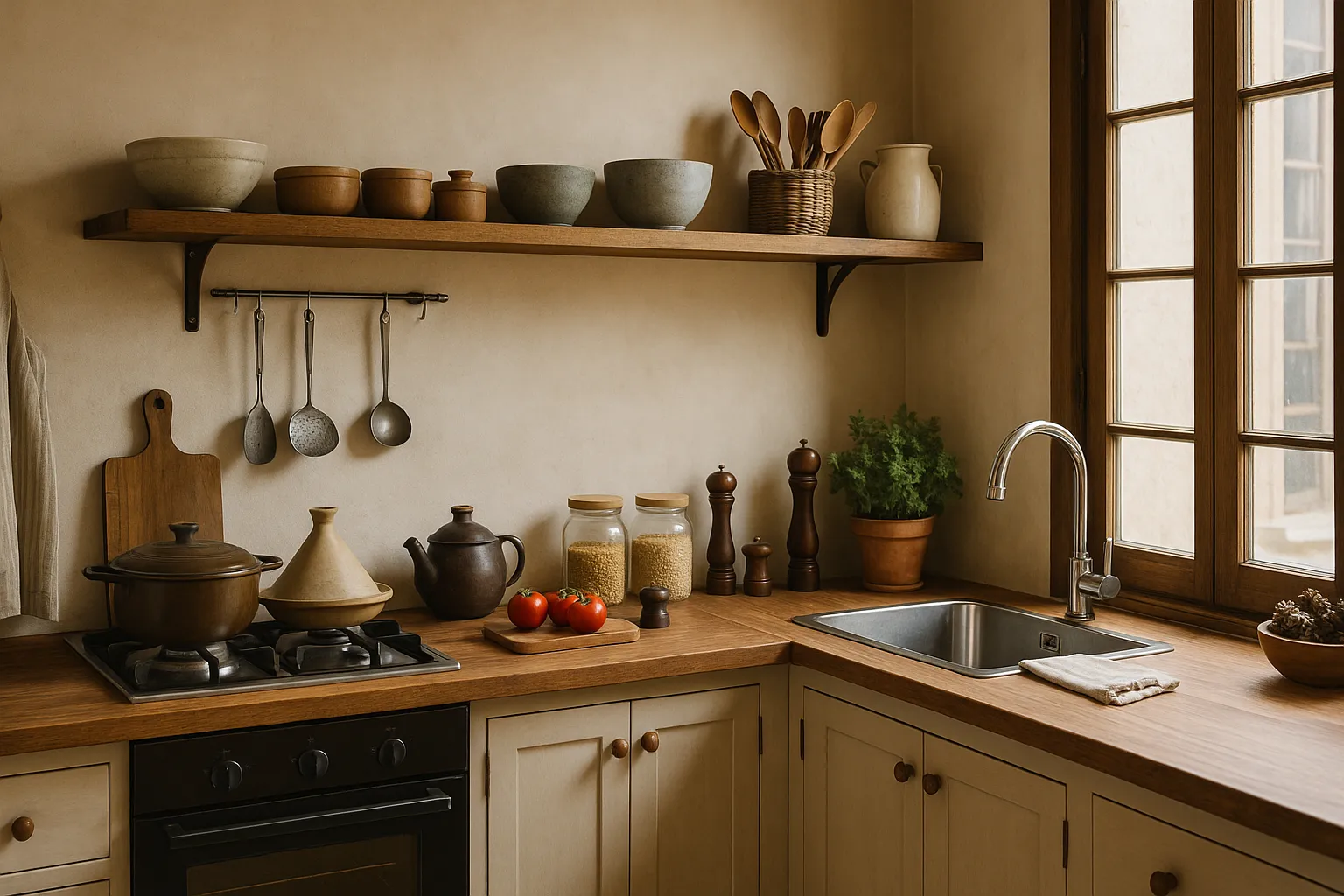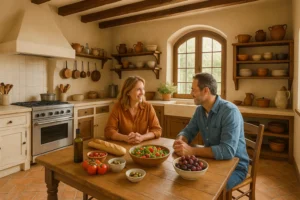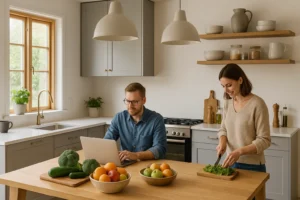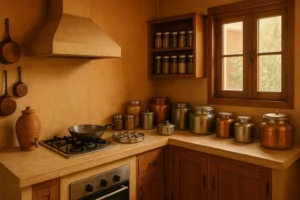Kitchens Across Cultures: What We Can Learn From Global Cooking Spaces

Luckily, cultural kitchen design from different countries offers practical solutions for both home cooks and serious food business owners. These proven strategies help food trucks use every inch, restaurants improve workflow, and commissary kitchens serve multiple businesses without chaos.
Here’s what we’ll cover:
- Japanese space efficiency for small areas
- Mediterranean warmth that draws customers closer
- Indian ventilation for heavy-duty cooking
- A Scandinavian organization that passes inspections
Let’s start with Japan, where space efficiency revolutionises both home and commercial kitchen layouts.
Japanese Efficiency: Small Space Solutions for Food Entrepreneurs
Food trucks and cramped restaurant spaces have found their design guru in Japanese kitchen philosophy. The reason is simple. Japanese cooks have spent centuries perfecting ways to do more with less space.
Come, let’s explore them:
Vertical Storage Systems That Double Capacity
Japanese cooks think upward when planning storage solutions. The approach makes perfect sense once you see the results. Successful food entrepreneurs install floor-to-ceiling shelving that doubles their equipment capacity without claiming precious floor space.
Meanwhile, wall-mounted racks hold pots, utensils, and dry goods in areas that most kitchens ignore completely. The vertical storage strategy saves serious money in shared kitchen facilities where rent depends on square footage.
Multi-Function Prep Areas for Food Business Efficiency
Japanese commercial kitchen design makes every inch work overtime, by creating surfaces that serve multiple purposes at once.
Starting with prep counters, these surfaces hide storage compartments underneath while supporting equipment mounts above. Then there are the rolling carts, which create a flexible workspace that adapts to different cooking demands throughout the day.
Best of all, the mobile setup means food entrepreneurs in tight spaces can cook multiple menu items without stepping on each other.
Clean Workflows That Speed Service
Japanese kitchens follow a simple rule: arrange everything so each cooking step flows naturally to the next one. As a result, the workflow principle cuts down confusion during rush periods. In practice, ingredients sit near prep areas, which connect directly to cooking stations and lead straight to plating zones.
This logical sequence cuts wasted motion and helps culinary professionals work faster when orders pile up. That’s why commissary kitchens adopt the same workflow principle to serve multiple food business clients without chaos.
While Japan maximizes small spaces, Mediterranean traditions show how open design builds community around food.
How Mediterranean Kitchens Create Connection
Mediterranean kitchens create a connection by treating cooking as a shared experience rather than a solo task. Take Italy or Greece, for instance. When food business owners visit these places, they notice that restaurants keep cooking areas open to dining spaces. The open layout lets customers watch chefs work as they eat.
Mediterranean families gather around large kitchen islands that pull double duty as dining tables. The setup keeps everyone talking while someone chops vegetables or stirs sauce. Food trucks benefit from this warmth by adding service windows that let customers interact with cooks directly.
Walk into any Mediterranean kitchen and you’ll find stone countertops, wooden cabinets, and clay tile floors. This setup brings natural warmth that plastic and steel can’t deliver. Commercial kitchen spaces gain character when food entrepreneurs choose materials that age beautifully.
We have heard that Mediterranean cooks don’t believe in keeping indoor and outdoor cooking separate. Restaurant patios become extensions of the main kitchen when the weather cooperates. Food business owners copy this idea by installing kitchen doors that open to outdoor seating areas.
Indian Spice Storage and Ventilation Secrets
In the food industry, while Mediterranean kitchens focus on openness, Indian kitchens deal with some tough cooking challenges. No worries, they also stand prepared with solutions.
Heavy-duty ventilation
Ever walked into an Indian restaurant kitchen during dinner rush? The air moves constantly because Indian cooks deal with heavy spices, deep frying, and high-heat cooking that would overwhelm standard restaurant exhaust systems.
That’s why food entrepreneurs benefit from installing commercial-grade fans that handle tandoor smoke and aromatic dishes without affecting neighboring businesses in shared kitchen spaces.
Organized spice systems
Picture opening a traditional Indian family’s spice cabinet and finding hundreds of perfectly labeled containers. These families organize spices in airtight containers arranged by cooking frequency rather than alphabetically.
When restaurant owners copy the same method, they help their culinary professionals get access to ingredients quickly during rush periods, cutting prep time significantly.
Heat-resistant surfaces
Standard kitchen materials simply can’t handle what Indian cooking dishes out. Granite countertops and stainless steel withstand the extreme temperatures that Indian cooking demands, while regular materials crack or stain within weeks.
Because of this durability, health departments approve these choices for fully licensed operations since the surfaces resist damage from high-heat cooking methods.
Multi-fuel kitchen appliances
Indian kitchens pack incredible variety into small spaces. Gas burners, electric equipment, and traditional ovens work together in compact arrangements, giving cooks maximum cooking flexibility.
As a result, food business owners save space while gaining versatility when their menus require grilling, steaming, and high-heat searing simultaneously.
The passion Indians hold for their cooking is unbelievable. From India’s practical innovations, we move north to Scandinavia’s serene approach.
Why Scandinavian Kitchens Work Well
What makes Scandinavian kitchens so appealing to food entrepreneurs and home cooks alike? The answer lies in their ability to combine beauty with serious functionality.
Light Colors and Food Safety
Scandinavian designers choose white and pale wood finishes for practical reasons beyond just looks. The light surfaces make it easier for culinary professionals to spot spills, stains, and contamination during food preparation.
As a result, commissary kitchens benefit from the same color choices because health inspectors can quickly identify cleanliness issues. The visibility helps businesses maintain their fully licensed status without constant worry about violations.
Natural Materials in Commercial Use
Wood cabinets and stone countertops age gracefully in high-traffic commercial kitchen environments, unlike synthetic materials that show wear immediately.
Over time, food business owners find that these natural choices save money because scratches and dents add character instead of requiring expensive replacements. The durability factor makes natural materials a wise investment for long-term kitchen operations.
Storage That Passes Inspections
Hidden storage compartments keep kitchen tools organized while maintaining the clean lines that health departments prefer during inspections.
Furthermore, food entrepreneurs who install pull-out drawers and concealed shelving create more storage space without cluttering their commercial kitchen area. The organized approach helps them pass regulatory compliance checks consistently while keeping equipment easily accessible.
Now that we’ve seen how different cultures solve kitchen challenges, it’s time to bring these global ideas into your own kitchen space.
Bringing Global Design to Your Kitchen Space
Global cooking spaces offer proven solutions for both home cooks and food entrepreneurs looking to improve their kitchen performance. Japanese efficiency helps maximize every inch through vertical storage and multi-function prep areas. Meanwhile, Mediterranean openness builds connection by showcasing cooking as a social experience rather than hidden work.
Indian heavy-duty systems solve problems for anyone who cooks with intense spices or high temperatures daily. The ventilation and heat-resistant materials protect your investment while creating comfortable cooking environments. Similarly, Scandinavian organizations create calm, efficient spaces that make daily cooking more enjoyable.
Ready to bring these global ideas into your own kitchen space? Sweet Lydia’s Kitchen specialises in blending cultural inspiration with modern functionality.
Contact us today to discuss how we can change your kitchen into the beautiful, efficient space you’ve always wanted.
